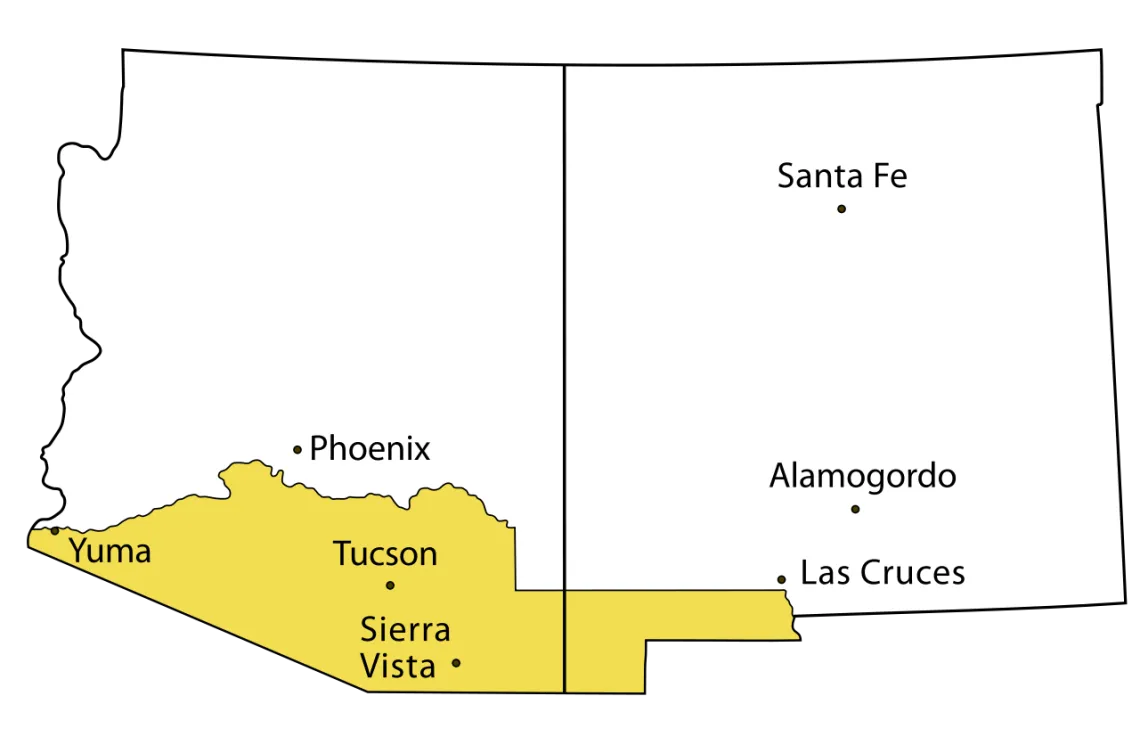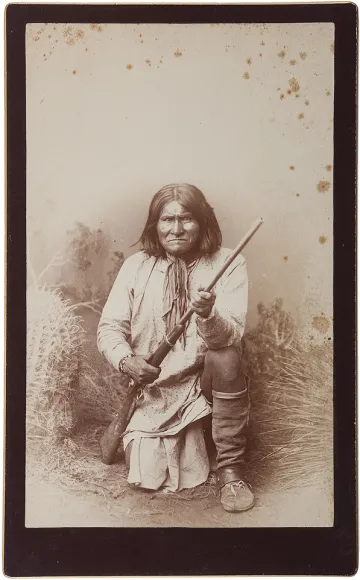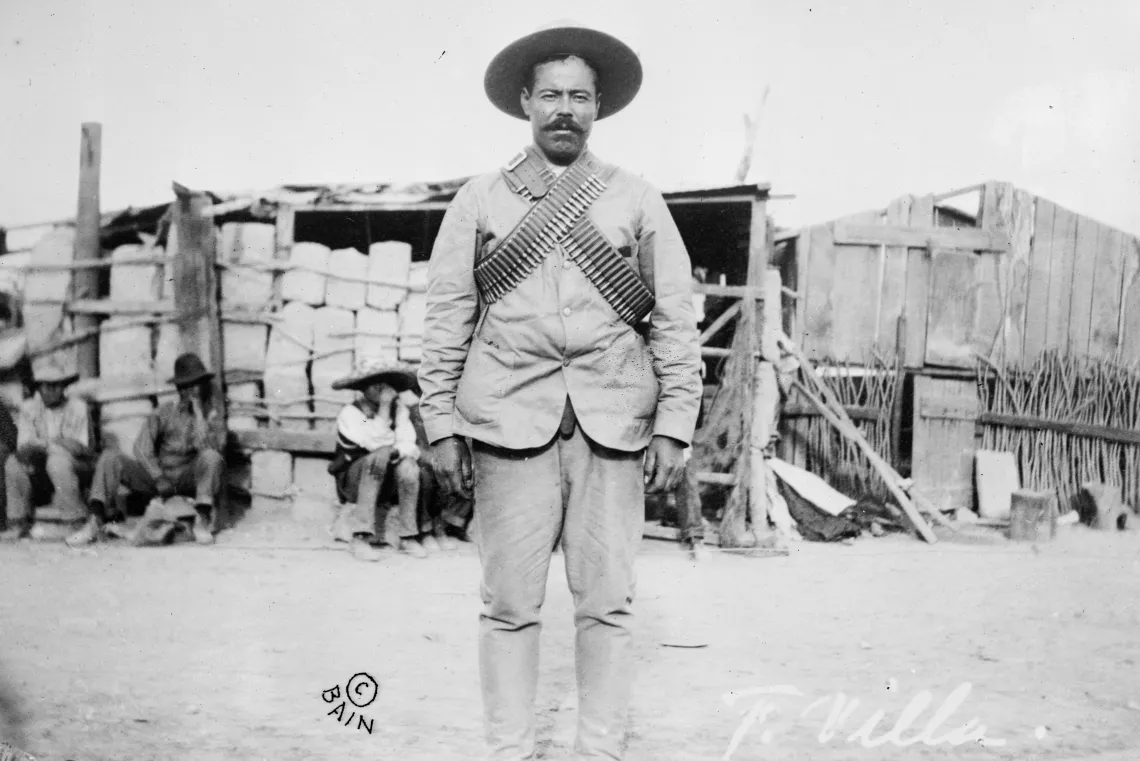
Gadsden Purchase, 1854.

Geronimo (Goyathlay), Chiricahua Apache, 1887. Public domain.
The Gadsden Purchase incorporated the area south of the Gila River into the American Union and was initially part of the Territory of New Mexico. The primary purpose of this acquisition was to provide a corridor for a transcontinental railroad linking Texas and the Southwest to California. In itself, the land was seen as remote, forbidding and dangerous, a region to be quickly traversed or avoided if possible. As a result of this perception, there was almost no civilian or military presence in the region for several years—in fact, Mexican forces remained stationed at Tucson until 1856, when they were finally relieved by American troops.At the outset of the American Civil War in 1861, the military largely abandoned the area as soldiers with allegiances to either side were drawn into the conflict to the east. Forces allied with the Confederate cause occupied the region briefly, but they were soon driven out by advancing Union troops from California. Throughout this period, Apaches maintained an antagonistic relationship with both European and Native populations. Hostilities peaked in the 1860s when the Chiricahua band of Apaches under Cochise sought to isolate Tucson. Most of the ranches and mining claims were abandoned during this period, and the local populations withdrew into Tucson or south into Mexico. Only the fortified ranch of Pete Kitchen, located north of Nogales, Arizona remained occupied during this period. Soon after the Civil War, the U.S. military actively campaigned against the Apaches; almost one-fourth of the U.S. Army was stationed in the Southwest at the time. In southern Arizona, Apache hostilities finally concluded with the surrender of Geronimo and his followers to General Nelson Miles at Skeleton Canyon in southeastern Arizona, and the subsequent deportation of the Chiricahua Apaches to Florida.
In 1863, Arizona was officially designated as a Territory, separating it from the New Mexico Territory, although a surveyor-general would not be appointed until 1870. The capital was initially located in Prescott, where the first legislative session convened in 1864. In the 1870s and 1880s—particularly after the arrival of the railroad in 1880—the population of the Arizona Territory expanded rapidly. As the Apache threat diminished, settlers intent upon exploiting agricultural and mineral resources arrived in the region. Mormon settlers moved south from Utah and Mexicans emigrated north. With the arrival of the railroad, the flow of European emigrants increased markedly, and African-American, Asian, and Jewish settlers joined them. African-Americans often came as soldiers or as laborers, while many of the Asian immigrants, of Chinese descent, migrated from northern Sonora to become merchants, to labor on the railroad, and to work for mining and agricultural interests. Jews who had fled pogroms in central and eastern Europe arrived in Arizona and became leading entrepreneurs. By the beginning of the 20th century, the population of the Arizona Territory exceeded 100,000. As the population grew, there was increasing sentiment for statehood, which was finally granted in 1912.

Francisco "Pancho" Villa (1877–1923), Mexican revolutionary general, wearing bandoliers in front of an insurgent camp. Public domain.
Following the conclusion of the Apache Wars, the military closed a number of posts across southern Arizona and concentrated troops in the remaining bases. Fort Huachuca was retained because of its proximity to the border with Mexico. In 1910, the first social revolution of the twentieth century broke out in Mexico, with several popular figures assuming leadership among the insurgents. Initially, troops from Fort Huachuca were sent to the border to prevent incursions by the renegades and to protect American citizens living along the border, especially around Nogales, where revolutionaries and federal forces clashed in March of 1913. In 1915, the U.S. recognized the Mexican leader Venustiano Carranza as the legitimate leader of Mexico. Another battle broke out there in November 1915, followed by an even larger violent episode in August of 1918 known as The Battle of Ambos Nogales (the two Nogales'). It was President Woodrow Wilson's recognition of Carranza, however, that provoked Pancho Villa, a competing rebel leader based in Chihuahua. Up to this point, Villa and his followers had been on relatively good terms with Americans along the border. However, with this development, Villa felt betrayed and his attitude changed dramatically. On March 9, 1916, Villa and a contingent of 485 followers crossed the border and raided the community of Columbus, New Mexico, for supplies. This invasion provoked an immediate response from the Wilson administration. By September, Brigadier-General John "Blackjack" Pershing had mobilized about 100,000 soldiers along the international border and soon crossed into Chihuahua, Mexico, to pursue Villa and his followers.
As part of the response to the threat, communities along the border such as Nogales, Naco, and Douglas were garrisoned with National Guard and regular U.S. Army forces. Forces patrolled the border from these outposts and from Fort Huachuca. Ultimately, efforts to capture Villa and his followers proved futile—though no further attacks were made on the border communities—and the forces were withdrawn as the United States entered World War I. In January of 1917, the last U.S. troops left Mexico at a cost of $130 million to the U.S. treasury.





